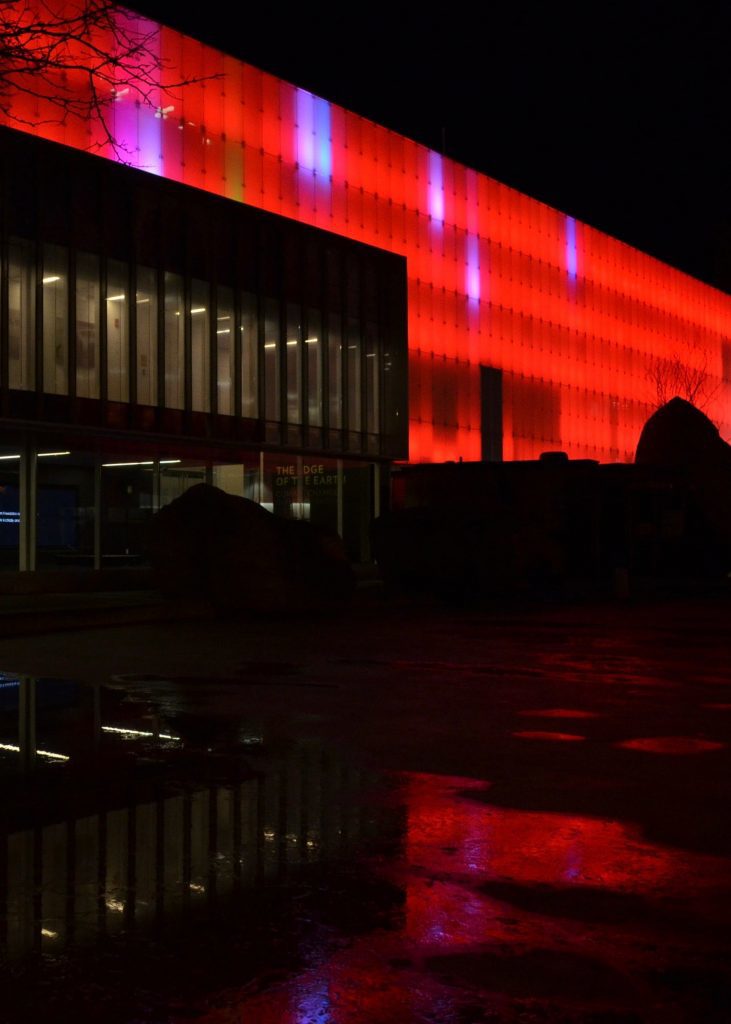The Ryerson School of Image Arts building was lit up red this week to bring awareness to the lives of missing and murdered Indigenous women, girls, transgender and two-spirit people as part of a project headed by eight Ryerson students.
The red lights, which reacted to real-time Twitter engagement and reflected in Lake Devo Monday, Tuesday and Wednesday evening, were done by the Shades of our Sisters initiative, the thesis project of a group of Ryerson radio and television arts undergraduates.
“We have seen a huge amount of engagement and we’re actually very happy about that,” said Laura Heidenheim, executive producer of the project. A social media campaign was created for the project featuring three hashtags; #MMIW (missing and murdered Indigenous women), #MMIWGT2S (missing and murdered Indigenous women, girls, transgender and two-spirit people) and #MMIWG (missing and murdered Indigenous women and girls).
Whenever the hashtags were used on Twitter, the building lights pulsed as a physical representation of people engaging with the initiative online, said Josephine Tse, project manager and digital director of Shades of our Sisters.
“What this building does is it incentivizes people to go online and engage with a conversation that they might not necessarily have been engaged with before,” said School of Image Arts building lighting coordinator Dave Colangelo, who helped program the setup. “Their cause draws attention to something that has long been neglected.”
Ryerson journalism professor and social media expert Gavin Adamson said the initiative’s use of hashtags was a good way of observing the exact impact their project was having, as it allowed the public’s “depth of engagement” with the project to be measured. “Any kind of campaign nowadays that doesn’t include social media would be, frankly, just missing an opportunity,” said Adamson.
The group of students used the lights to promote the second step of their project, an installation in February centered on the lives of two Indigenous women, Sonya Cywink and Patricia Carpenter. Cywink, from Whitefish River First Nation, was found dead on Aug. 30, 1994, in Elgin County, Ont. Carpenter, from Alderville First Nation, was found dead on Sept. 29, 1992, in a Toronto construction site.
Heidenheim said the installation, which will be in the Tecumseh Auditorium at Ryerson University from Feb. 17 to Feb. 19, will feature a 10-minute documentary on each woman, as well as two distinct spaces filled with physical artifacts and media telling the stories of each woman’s life.
Upon entering the installation, each visitor will be given a bundle of tobacco to hold throughout their visit, and when leaving, can choose to offer it back to the families of the women or to place the bundle somewhere in nature, said Heidenheim. “It’s thought to be you offering your respect and your prayer for the families.” The tobacco offered back would be brought to the women’s home communities to be used in a sacred fire.
First-year Ryerson political science student Aryana Bains said Shades of our Sisters is filling an important knowledge gap among millenials. “In my political science class at the beginning of the year, only one person knew what MMIW stood for, and that person was an Indigenous woman.” The hashtag campaign struck her as inappropriate though, as she didn’t think such a complex topic could be given a “word limit”, referencing Twitter’s format of limiting tweets to 140 characters or less.
The public has noticed the red lights of the School of Image Arts building though, and Colangelo said that that is what is most important. “Our public spaces are reflections of who we are as a culture,” he said, and this project “represents, in a way, what it is that we value as a community and as a school.”

Laura Heidenheim, executive producer of the Shades of our Sisters project, speaks about the eventual installation taking place at Ryerson University, as well as the roll of social media in the initiative.


